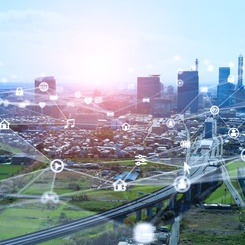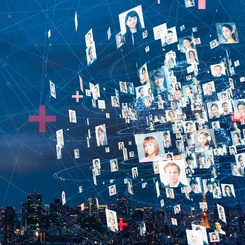The future has arrived faster than we thought. In less than one week, office workers around the world (albeit not concurrently) packed their essential tools (computers, some books, some folders), carved a work space in a corner of their home, scribbled ‘ON AIR’ on a sheet ready to be pasted outside their improvised office’s door, and started working remotely with colleagues they were used to seeing in person. Even taking into account the many who were used to working remotely part-time or on occasion, the speed of adjusting to working 100% remotely has been remarkable. Despite physical distance, we have been making use of the abundance of technology at our fingertips to feel close to colleagues, managers, and friends.
The same goes for students and faculty in universities around the world. From one day to the next, faculty migrated in mass to online teaching. For some, it was the first time they delivered their courses online. Students, more familiar with technology but still used to seeing their teachers ‘in the flesh,’ were equally, if not more, quick to adapt. Students’ transition often came in difficult circumstances, such as in a tiny room in a student residence, far away from family and friends or in their homes, in spaces not conducive to academic work, with stress about their job prospects in the post-pandemic economy looming over their new learning environment. Many students went from living on campus or close by to living with their families again, often far away from their peers and professors, sometimes in different cities, time zones, or even countries. Despite these challenges, students participated fully, even enthusiastically, in the new online courses.
For all, formal meetings became a row of faces on Zoom, or Microsoft Teams, or Google Hangouts. Informal encounters, long thought as key to innovation, disappeared. And still, work is getting done, projects are advancing, and new ideas are springing up and being implemented.
How is this possible? How is it possible to feel so close with people who are so far away?
Clearly, when faced with a dangerous situation, people prove to be remarkably resilient, flexible, and resourceful. Very likely, the pandemic accelerated trends already deep at work in organizations and societies. The omnipresence of technology, combined with the urgency to protect human lives, led to a leap in adopting new work practices. Both explanations are reasonable. They are also compatible with the results of a study in which I examined the factors that make people feel close to faraway colleagues.
My research identifies specific factors that help explain the speed and smoothness of the adaptations to remote work. Together with my co-authors, Michael Boyer O’Leary (Georgetown University) and Jeanne Wilson (The College of William & Mary), we used the term perceived proximity to designate the feelings of closeness between coworkers, collocated and remote.
In the BC (before Covid-19) world, our study showed that the real (physical) distances between colleagues (objective proximity) actually had generally weaker or mixed relationships with feelings of closeness (perceived proximity) – and no effect on relationship quality. In other words, on average, people felt as close to their remote collaborators as they did to collocated ones.
A few years ago, those findings were surprising. Nowadays, they seem premonitory.
We also found that people develop feelings of closeness with distant others when they communicated, via technology, to uncover deep similarities, and to develop a pool of shared experiences. While it may seem impersonal, technology can be used to build community and connections: think of the popularity of dating applications and social media networks. It makes sense that technology can also be used in a workplace setting to stay connected (in both senses of the word) to our colleagues, despite being physically distant.
These findings help explain the speed and effectiveness of the adaptation. In the first weeks of the lockdown, co-workers relied on an existing pool of shared experiences, and students often know one another from around campus. Further, we shared in the strangeness and stress of adjusting to the new normal.
BUT as the crisis continues, and as organizations and employees decide they want to continue, at least partially, to work remotely, that pool may decrease – due to turnover, expansion in new markets, and so on. Therefore, managers and leaders should refrain from declaring the transition a success and simply carry on with the current practices. With time, the loss of context will increase, with negative effects on collaboration and morale. Therefore, it is in the following weeks and months that managers and indeed all employees will have to make an effort to prevent this huge loss of context from impeding collaboration.
What does that look like in practice? Below are a few recommendations based on previous research and adapted to the current climate.
The first two recommendations are based on my previous article:
1. Ensure that dispersed teams have time to bond.
It is important to carve out time to identify, learn, and discuss areas of common ground because this creates a basis for trust and strong relationships. Thus, teams must fight the tendency to be hyper-task-focused; people need the opportunity to identify deep similarities (attitudes toward work, reliability, values) as opposed to surface similarities (demographic characteristics). What matters is that the technology enables the creation of vivid images of the faraway others, that it reduces uncertainty about the others’ work, and helps envision the other’s context. For example, managers could implement regular virtual “coffee breaks”, where team members have the chance to chat about both work and non-work subjects much as they would in person.
2. Overcommunicate in predictable, regular ways.
This may seem painfully trite, but I see the volume and predictability of communications as a major lesson (from our work and others) to combat especially fuzziness surrounding role clarity, heightened tendency to run up the ladder of inference and make faulty attributions, and to keep conflicts from escalating.
There's nothing worse in remote work than putting something out for team members to consider and then just not hearing back from them. Did they not like my idea? Are they swamped with work? Did they have a holiday I've forgotten about? Or maybe something's really wrong there? I don't recall any big news stories, but maybe I missed something. .... You get the idea. The wheels spin too quickly when teammates are out of contact. This can be especially complicated given the particular conditions of the crisis, such as partial unemployment and homeschooling, that mean people may be on different schedules than previously. Under these conditions, it is all too easy for emails and messages to fall through the cracks, especially when you don’t see colleagues in the hallways to jog your memory.
How can we avoid playing a game of Broken Telephone? One way to do this is by establishing regular calls as a larger group and in smaller breakout groups, where all members share what they have been working on and people have the opportunity to ask questions or make comments. Regular meetings will also ensure that team members have a sense of each other’s workloads, holiday time, etc., to reduce the possibility that wires get crossed along the way.
To (attempt to) coin a phrase, it's not so much absence or distance that matters as it is silence. As Daniel Barenboim, the great conductor, says when discussing Wagner, “Sound tends to go to silence, unless it is sustained.”
This is the job of project managers, to lay the infrastructure for the sound, for the communication.
The next 2 recommendations are tailored to the current crisis:
3.Trust your employees and colleagues.
The next managerial implication is that employees can be trusted – both in crises and in normal times. Most of the adaptations to the Covid-19 crisis were done individually; often with the guidance of their hierarchical superiors and the technical assistance of their IT colleagues. But we can agree that the switch to online work was largely due to individual efforts, initiatives, and ideas. People value this autonomy that makes them feel valuable (and sometimes, when their efforts are recognized and praised, also valued). They want to maintain this autonomy, so far touted as the prerogative of an elite, the white-collar workers. So managers will have to first recognize the employees’ efforts, congratulate them, and open frank discussions about how employees see the future of work and about the practices and lessons from the crisis period worth maintaining in a – hopefully – calmer future. An oft-repeated concern about remote work is its impact on productivity, with some worried that employees may get distracted and work less effectively when at home. Past research has indicated that this is not the case and that in fact, productivity can improve when working remotely (c.f. Bloom et al., 2014), highlighting the importance of trusting your employees and colleagues to get the job done.
A related recommendation is that there is no reason for not extending this invitation for frank discussions about the desired way to accomplish one’s work to employees who did not switch to remote work because of the sectors in which they operate. Cashiers, nurses, doctors, drivers, cleaners, and other essential workers have all adapted to working in dangerous conditions. They did so without so much as a murmur. With increased danger comes increased responsibility and dignity. Let’s acknowledge that this dignity includes the right to have a say in the way their work is organized and executed.
4. Listen to employees’ larger concerns.
Another recommendation is to listen to employees who may have to deal with increased strain due to family and home-related issues. The Covid-19 crisis revealed that the home front can be a huge source of stress for employees, due to cramped lodgings, home-schooling, and even domestic violence. While it is not managers’ responsibility to resolve such issues, being attentive to the particular needs of some employees, adjusting schedules so as to help alleviate the stress when possible, or lending a friendly ear can go a long way in helping a person under strain.
One way to do this would be by encouraging people to join virtual meetings early and leaving time for socializing at the end. This gives people the opportunity to have informal discussions. Another, more proactive way, is to offer a friendly ear for those who need it.
Managers may also want to encourage people to use Zoom working together in silence – the presence of others focused on their work helps us stay focused on ours. Such practices may also be conducive to casual conversations and quick questions. An initiative like this would need to be implemented carefully and with the recognition that not everyone may be comfortable with this, but it could be a means to foster the “closeness” that develops naturally when sharing an office with someone.
In times of crisis, people tend to learn a lot about themselves and about the world. The lessons from the current crisis will continue to be revealed over time, but we know one thing already. While we may not be in the office with our colleagues every day, sharing offices and chatting by the coffee machine, we can still nurture our relationships and work together productively. In other words, we could be faraway, and yet feel so close.
References
Bloom, N., Liang, J., Roberts, J., & Ying, J. (2015). Does working from home work? Evidence from a Chinese experiment. The Quarterly Journal of Economics, 130(1), 165-218.
O'Leary, M. B., Wilson, J. M., & Metiu, A. (2014). Beyond being there: The symbolic role of communication and identification in the emergence of perceived proximity in geographically dispersed work. Management of Information Systems Quarterly, 38(4), 1219-1243.
|
|
|||||









